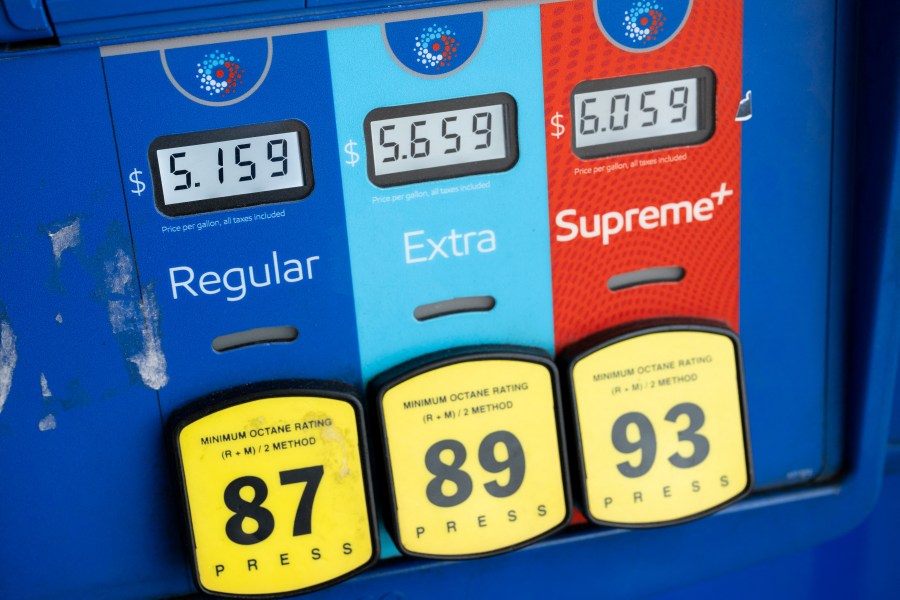Are you picking the right gas at the pump? How to know

(NEXSTAR) – If you drive a car, you’ve undoubtedly pumped gas before (unless you only drive in a state that pumps your gas for you). Maybe you visited a simple pump with just one option, or maybe you’ve had to decide between a few.
If you find yourself with more than one option at the pump, it can be hard to choose the right one. Depending on the pump, you could find yourself with as many as four or five different options, including numbers ranging from 85 to 93 or terms like “super unleaded” or “supreme” – the selection can be overwhelming.
First, it’s important to understand what those numbers even mean.
At most gas pumps, you’ll have three selections – 87, 89, and 92 or 93 – AAA spokesperson Devin Gladden tells Nexstar. Those numbers reflect the fuel’s octane level, which is a measure of the fuel’s stability, according to the U.S. Energy Information Administration.
Ratings reference the pressure at which a fuel will spontaneously combust in a testing engine. The octane rating is an average of two rating methods: motor octane rating and research octane rating. The higher the rating, the more stable the fuel, EIA explains.
The number that appears on the gas pump’s octane label is the minimum octane rating, according to the EIA. The labels often even explain the math: the research octane rating plus the motor octane rating, divided by two.
Retailers base their grades of gasoline at the pump based on the octane levels. As EIA explains, the lowest octane level (usually 87) is considered regular, 89-90 is midgrade, and premium has the highest octane level at 91-94. Other terms like unleaded, super, or super premium may be used instead.
The pump seen below, for example, uses regular, extra (midgrade), and supreme+ (premium).

“It just depends on the retailer and what kind of additives they use. The main difference is the amount of ethanol used,” Gladden explains. For higher-grade gases, those in the 90s, there are additional additives that benefit certain engines.
Depending on where you live, you may find yourself at a pump with biofuels, like E15 or E85. The EPA defines E15 as gasoline blended with 10.5% to 15% ethanol, while E85 refers to “high-level ethanol-gasoline blends containing 51% to 83% ethanol” depending on where the gas station is and what time of year it is.
Gladden also notes that the reason one grade of gasoline costs more than another is all up to the retailer.
“Typically, what you find is that the different gas stations are using different proprietary blends and additives, particularly when you’re looking at the higher levels for premium gasoline. And those additives can add costs,” he says.
Mixing different fuel blends – like filling up with premium when you usually use midgrade – can cause problems.
“That’s why we stress that drivers should really focus on what is necessary for their vehicle because everybody’s vehicle is different,” Gladden explains. “Typically at the lower grades, it’s pretty much uniform, but it can vary as you start to mix in those different compounds that can impact the vehicle’s performance.”
When it comes to actually picking which grade of fuel to put in your vehicle, Gladden recommends checking your owner’s manual. You can also check which fuel type is best for your vehicle by using the Department of Energy’s fuel economy website. Here, you can check vehicle makes and models dating back to 1984.
A 2023 Ford F-150 (one of the most popular vehicle models in the U.S.), for example, should use regular gasoline. A 2023 Lexus IS 350, considered the most reliable luxury car by iSeeCars, should use premium gasoline. A 2023 6-cylinder Dodge Challenger should use regular gasoline, but an 8-cylinder should use midgrade.
Additionally, the website can tell you whether you can use ethanol fuels or diesel.
The national average for a gallon of regular gasoline has been declining over the last few days, data from AAA shows. As of Tuesday, the average sits at $3.41, down from $3.43 last week.
Copyright 2023 Nexstar Media Inc. All rights reserved. This material may not be published, broadcast, rewritten, or redistributed. Regular the hill posts







